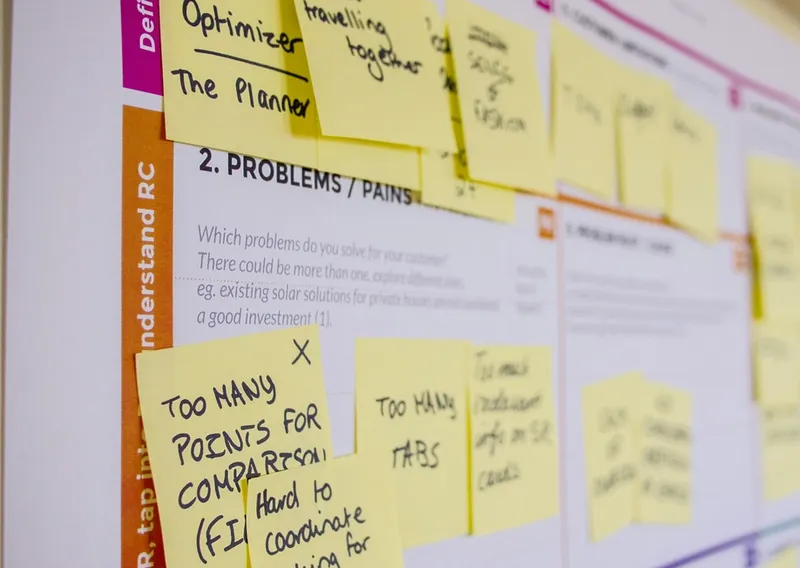The daily standup starts at 09:00 sharp. Seven people dial into the video call, cameras mostly off. The first developer gives their update about working on the user authentication feature with no blockers. The next person continues with the API integration, also no blockers. By the fourth person, you can see team members checking emails, browsing phones, clearly tuned out.
Later that week, the sprint planning session drags on for three hours. The poker planning for a simple form validation feature sees the usual suspects (two senior developers) dominating the discussion whilst everyone else stays muted. When voting time comes, most cards show "5" because it's the safe middle ground that ends the debate quickly. The team lead asks if anyone has questions. Silence.
The authentication developer discovers during deployment that their work conflicts with the API integration changes. Neither mentioned this dependency during any of the five ceremonies they attended together this week.
Perfect Scrum compliance has created the illusion of collaboration whilst actually preventing it. Teams are ceremony-compliant but strategically disconnected. Real strategic agility emerges when you eliminate the performance of process and focus on genuine organisational responsiveness.
Why Agile Became Process Theatre
The transformation from revolutionary methodology to bureaucratic overhead didn't happen overnight. It emerged through a perfect storm of misunderstanding, consultant dependency, and the natural human tendency to turn principles into rigid processes.
The Certification Industrial Complex
Agile's original manifesto valued "individuals and interactions over processes and tools." Somewhere along the way, we built an entire industry around processes and tools. Scrum Master certifications proliferated faster than actual understanding. Organisations hired agile coaches who measured success through ceremony attendance rather than strategic outcomes.
Research supports this pattern. McKinsey's analysis of over 2,000 organisations found that those achieving genuine agility focus on building stable foundations whilst enabling dynamic responses to change. According to their findings, truly agile organisations paradoxically learn to be both stable and dynamic, rather than choosing between speed and structure. The most successful transformations create what they term "stable backbones with dynamic applications."
Teams spend more time planning their retrospectives than acting on previous retrospective insights. Sprint velocity became a KPI divorced from business value. Teams optimised for story point completion rather than customer impact. The dangerous shift from "being agile" to "doing agile" created elaborate performance art that looked like collaboration but delivered only process compliance.
The Framework Trap
Scaling frameworks like SAFe promised to bring agile discipline to enterprise environments. Instead, they often added layers of coordination overhead that slowed decision-making rather than accelerating it. Agile Release Trains became the new project management bureaucracy, complete with program increment planning sessions that made traditional project reviews look efficient.
How did a methodology designed to eliminate wasteful meetings create environments where teams spend 30% of their time in ceremonies? The answer lies in treating frameworks as destinations rather than starting points. When certification becomes more important than strategic responsiveness, you've lost the plot entirely.
Missing the Strategic Context
Most agile implementations never escaped the development team level. While engineers perfected their sprint ceremonies, executive decision-making processes remained unchanged. Strategic planning still happened annually. Market insights took months to influence product direction. The disconnect between two-week sprints and quarterly business reviews created organisational schizophrenia.
Agile methodologies were designed to help development teams respond to changing requirements, not to create organisational adaptability. We tried to scale development practices into business strategy without understanding the fundamental differences between tactical execution and strategic positioning.
What Strategic Agility Actually Looks Like
Strategic agility isn't about ceremony frequency or process compliance. It's about building organisational capabilities that enable intelligent response to change whilst maintaining strategic coherence.
Decision Speed Over Process Speed
A global e-commerce company's "disagree and commit" principle demonstrates real strategic agility. When leadership disagreed with the team's decision to create an original content division, they committed to supporting it fully rather than creating extended debate cycles. The decision speed enabled learning speed, which created competitive advantage.
Strategic agility means shortening the time from insight to action. This requires removing decision bottlenecks rather than optimising development cycles. When market signals suggest product direction changes, how quickly can your organisation pivot resources? The answer reveals more about your strategic agility than sprint velocity metrics ever could.
MIT Sloan research on strategic agility identifies that most organisations struggle to achieve strategic alignment. In an analysis of 124 organisations, only 28% of executives and middle managers responsible for executing strategy could list three of their company's strategic priorities. This disconnect between strategy formation and execution creates the exact organisational dysfunction that agile ceremonies were meant to solve.
Information Flow That Enables Action
Genuine strategic agility requires sensing mechanisms that surface strategic signals early. This isn't about better reporting systems. It's about creating communication pathways that connect front-line insights to strategic decisions without multiple translation layers.
A leading streaming platform's culture of context-sharing enables employees at every level to make decisions aligned with strategic objectives. Teams don't need permission to respond to customer feedback or competitive moves because they understand the strategic context for their work. Information flows to enable action rather than to satisfy reporting requirements.
The difference between reporting systems and decision-support systems determines strategic responsiveness. Reporting systems tell you what happened. Decision-support systems help you determine what to do next.
Resource Flexibility Without Chaos
Strategic agility requires maintaining strategic direction whilst allowing tactical adaptation. This means building capability portfolios that can pivot quickly without losing strategic focus. A major technology company's transition from computers to mobile devices demonstrates this discipline. They maintained focus on user experience excellence whilst completely changing their product portfolio.
Building teams that can scale up or down based on strategic priorities requires different thinking than traditional resource planning. Instead of optimising for efficiency, you optimise for adaptability. Instead of minimising redundancy, you build strategic options.
Building Strategic Responsiveness Without Methodology Overhead
Moving beyond agile theatre requires building three foundational capabilities that enable strategic responsiveness without process bureaucracy.
Decision Architecture
Design decision rights that enable speed without sacrificing quality. This means establishing clear escalation paths that don't create bottlenecks. Most organisations have too many decision-makers for tactical choices and too few for strategic ones.
Distributed decision-making frameworks require appropriate guardrails. A leading technology company's OKR system demonstrates this balance. Teams have autonomy to determine how they achieve objectives whilst maintaining alignment with company-wide key results. The framework enables independence within interdependence.
Decision architecture isn't about eliminating oversight. It's about ensuring oversight enables rather than constrains intelligent action. When your approval processes take longer than your competitors' implementation cycles, you've optimised for control rather than strategic advantage.
Information Systems
Build sensing capabilities that detect strategic shifts early. This requires more than dashboards and metrics. It requires systematic approaches to gathering, processing, and acting on strategic intelligence from multiple sources.
Create feedback loops between strategic initiatives and market reality. Traditional strategic planning operates on annual cycles that assume stable conditions. Strategic agility requires continuous sensing and course correction based on changing conditions.
Research from management scholars confirms that successful agile organisations maintain "strategic consistency" whilst enabling tactical flexibility. This balance prevents the organisational whiplash that occurs when companies constantly change direction without maintaining core strategic coherence.
Regular strategic sensing sessions that inform direction changes should replace quarterly business reviews focused on variance reporting. The goal shifts from explaining deviations from plan to identifying opportunities for strategic advantage.
Resource Mobility
Maintain strategic focus whilst enabling tactical flexibility. This requires investment frameworks that support rapid reallocation based on strategic priorities. A major e-commerce platform's practice of funding small teams with specific customer problems demonstrates resource mobility in practice.
Build strategic agility into existing leadership processes rather than creating separate agile roles. When strategy sessions focus on capability building rather than just resource allocation, you create the foundation for intelligent adaptation.
The measure of resource mobility isn't how quickly you can hire people. It's how quickly you can apply existing capabilities to new strategic priorities.
Making the Transition
Moving beyond agile without losing adaptability requires careful attention to what's actually working versus what's just familiar.
Audit Through Strategic Lens
Examine your current agile practices through a strategic responsiveness filter. Which activities enable faster strategic response? Which represent process theatre? The daily standup that generates no coordination becomes a status meeting. The retrospective that produces the same improvement suggestions every month becomes a compliance ritual.
Start building strategic responsiveness directly rather than hoping methodology adherence will create it. This might mean eliminating some ceremonies entirely whilst strengthening strategic sensing capabilities.
Common Transition Challenges
Teams invested in current agile practices often resist changes that feel like "going backwards" to less structured approaches. The key lies in demonstrating that strategic responsiveness requires different capabilities than process compliance does.
Avoid the pendulum swing back to rigid planning approaches. Strategic agility isn't the opposite of agile methodology. It's the evolution beyond methodology dependence toward capability building.
Success indicators include faster strategic decision cycles, improved market response times, and better connection between strategic intent and operational execution. Most importantly, reduced process overhead with maintained or improved outcomes.
Strategic agility isn't about methodology compliance. It's about building organisational capability to respond intelligently to change whilst maintaining strategic coherence. The organisations that master this capability will outmaneuver those still debating framework adherence.
Audit your current agile practices through a strategic lens. Which activities enable faster strategic response? Which are process theatre? Start building strategic responsiveness directly rather than hoping methodology adherence will create it.
The future belongs to organisations that can sense, decide, and act faster than their competitors. Process compliance won't get you there, but strategic capability building will.




